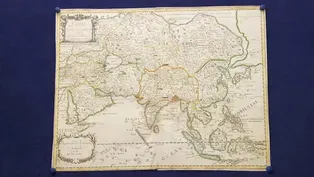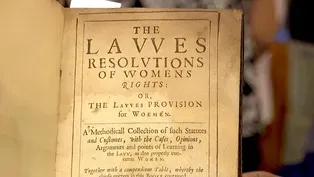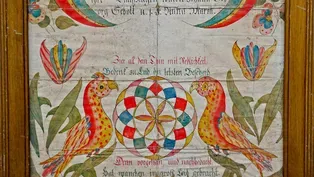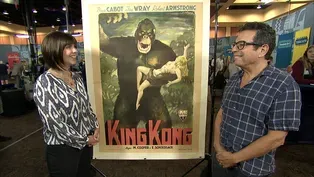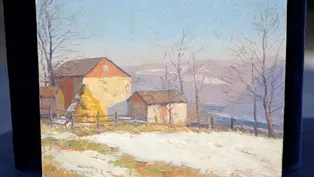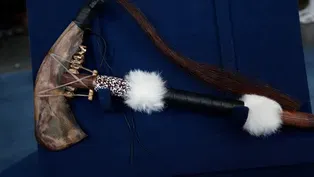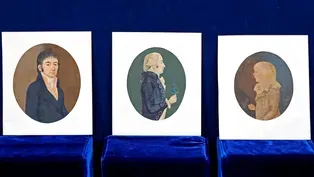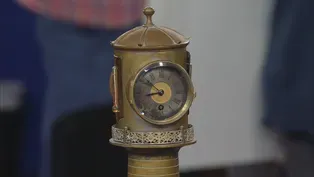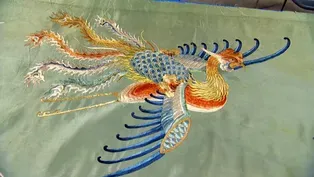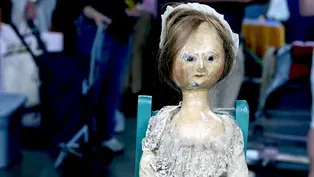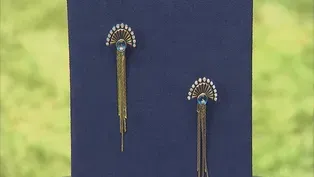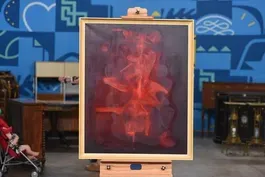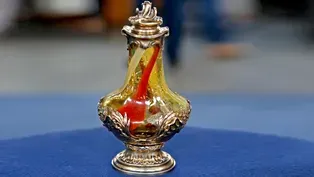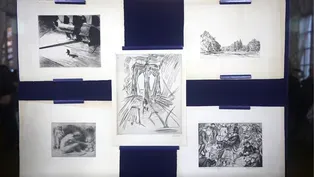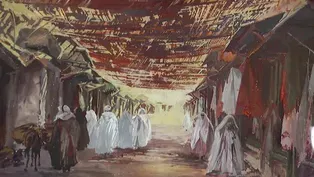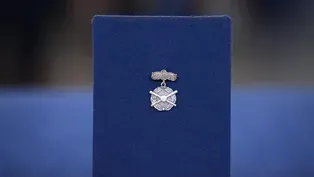
Best Bargains
Season 25 Episode 21 | 52m 16sVideo has Closed Captions
Steals and deals abound as ROADSHOW features great bargains like a $15K-$25K find!
Steals and deals abound as ROADSHOW features great bargains including a Chiparus sculpture, an 1811 North Carolina fraktur, and "New Republic Portfolio" prints. Which of these was found at a flea market for $40 and is now valued at $15,000-$25,000?
Problems with Closed Captions? Closed Captioning Feedback
Problems with Closed Captions? Closed Captioning Feedback
Funding for ANTIQUES ROADSHOW is provided by Ancestry and American Cruise Lines. Additional funding is provided by public television viewers.

Best Bargains
Season 25 Episode 21 | 52m 16sVideo has Closed Captions
Steals and deals abound as ROADSHOW features great bargains including a Chiparus sculpture, an 1811 North Carolina fraktur, and "New Republic Portfolio" prints. Which of these was found at a flea market for $40 and is now valued at $15,000-$25,000?
Problems with Closed Captions? Closed Captioning Feedback
How to Watch Antiques Roadshow
Antiques Roadshow is available to stream on pbs.org and the free PBS App, available on iPhone, Apple TV, Android TV, Android smartphones, Amazon Fire TV, Amazon Fire Tablet, Roku, Samsung Smart TV, and Vizio.
Buy Now

ANTIQUES ROADSHOW 2025 Tour!
Enter now for a chance to win free tickets to ANTIQUES ROADSHOW's 2025 Tour! Plus, see which cities we're headed to!Providing Support for PBS.org
Learn Moreabout PBS online sponsorship♪ ♪ CORAL PEÑA: We all dream of finding a bargain.
I brought this chair that I got at a thrift store, brought it home.
It was, like, $12.
Can I ask what you paid for them?
For all of them, $25.
PEÑA: It's "Antiques Roadshow: Best Bargains."
♪ ♪ PEÑA: In this episode, we're revisiting some of the greatest buys discovered on "Roadshow": tales of our savvy, or maybe just lucky guests getting the deal of a lifetime.
MAN: Well, I found them at a local thrift store and they were in a bin, and they were 25 cents apiece.
But I decided to go ahead and, and purchase it, and ended up paying six dollars for this piece of art.
Six dollars?
PEÑA: Just how marked down were their purchases?
And would they still be considered a steal in today's market?
(laughs): Oh, my God, are you serious?
I am serious.
Oh, my goodness!
I am.
See?
Women's rights, they come back... Wow, woo-hoo!
PEÑA: Find out in this look back at some of our best bargains.
A friend told me about an estate sale in Dallas, so my son and I decided to go.
We went on the last day of the estate sale.
When we entered the house, I saw this leaning against the dining room wall on the floor, and I was just drawn into the red color.
I'm not an abstract collector, I don't know anything about abstract.
I'm very more traditional.
Being that I'm Hispanic, I just saw, like, like, a flamenco dancer sort of like the, with the red hues.
It just spoke to me in that manner.
When I told my son I wanted to buy the piece of art, he said, "Oh, Mom, don't get it, it's ugly."
But I decided to go ahead and, and purchase it and ended up paying six dollars for this piece of art.
Six dollars?
So how long ago did you purchase it at the estate sale?
About four to five months ago.
Your son should always listen to you.
Sons should always listen to their mothers.
(chuckles) But this is a really interesting example of an abstract painting by the Cuban artist Felipe Orlando.
It's oil on canvas.
Orlando was born in 1911 in Mexico, but spent the bulk of his career in Cuba, from 1914 until 1946, which is a very vibrant time to be in Cuba.
He was influenced by artists like Tamayo, and also European artist Jean Dubuffet.
But when we look at paintings like this, his own instincts for the Afro-Cuban style, as well as his interest in pre-Columbian anthropology comes through.
It's quite abstract, but there's a lot of figure studies going on.
It's really a wonderful example of his work.
The piece is signed and measured on the back, and also, the artist has put an arrow to show which way is down-- the typography corresponds with that direction.
In the '50s, the artist moved back to Mexico.
And this was probably painted in the 1970s or '80s.
His work is in the Museum Nacional in Havana, as well as in the Museum of Modern Art in New York, and at the Museum of Latin American Art in Washington.
So, a very established artist.
It's in great condition, and at auction, I would estimate it at $4,000 to $6,000.
Wow.
Wow, not a bad investment.
(laughs) If it were earlier and painted in Cuba, it would have a different scale of value.
WOMAN: I brought a pair of earrings that I found at an estate sale.
It was the second day and they were marking everything down, and I saw them and I said, "Well, I really like them," and I got them for my daughter.
I don't think they knew that much about them, except they said they were gold.
When I looked at them, what I found was, is that they're, they're 14-karat gold with white gold around the centerpiece there.
There's, there's a topaz in the middle, and in the white gold, we have round, brilliant-cut diamonds.
Oh, they are diamonds.
They are, indeed, so, and they're a beautiful pair.
They're from around the 1940s.
Very retro in style.
But I found something more important on there.
Did you see that they were signed on the back?
I didn't pay much attention.
Yeah?
Okay.
No, I just liked them and I didn't pay that much for them, and I thought, "Well, whatever."
They were just beautiful and you liked them.
They're beautiful, and I thought they'd look gorgeous on my daughter.
They're by a designer named Romain Tirtoff.
His initials are R.T., which in French is Erté.
Oh, Erté.
And what I noticed is that they're signed on the back.
He was a well-known designer.
He designed a variety of different subjects like decor, he did bottles for Courvoisier, he designed sets for Louis B. Mayer, designed clothing.
So he was a very talented artist.
He's a Russian-born designer who moved to France, and they still produce his materials up until the late '70s, '80s, and, because he passed away in 1990.
So he had a long, prolific life.
He did.
He was more well-known for his Art Deco designs that he did.
But this was right after his Art Deco era.
Beautiful pair of earrings, and I'm sure they'll make a great gift for your daughter.
Do you remember what you paid for them at the estate sale?
Yeah, they were asking $300, and I offered $150 and they took it.
Oh, wow, that's a great deal.
Is that a good deal?
That's an excellent deal.
I believe that if we were to see these in a retail environment, they would probably sell them for around $3,000.
Seriously?!
Seriously.
Oh, wow, maybe she won't get them.
(laughter) My wife always says I'm very cheap, and I'd call it frugal.
They had it for $1.50 at a yard sale, and I said, "Well, that's within my price range," so...
Your dollar and a half at the yard sale bought you an 18-karat-gold-enameled cigar band ring from Cartier.
All right.
I guess it pays to be cheap.
I guess so, huh?
(laughter) WOMAN: Well, I bought this from a thrift store.
I was actually looking for something to serve mashed potatoes in.
I paid $33.
We do believe it is the work of Galileo Chini.
We see a date, 1925.
At auction, I would estimate it between $5,000 and $7,000.
No way.
No-- really?
WOMAN: My husband and I went to a local auction gallery.
We saw this, I liked it a lot.
My husband thought it was big and we probably didn't need it.
What'd you pay for it?
$35.
About nine or ten years ago.
Nine or ten years ago.
Mm-hmm.
It's probably mid- to late 19th century.
It's quintessentially something that's a Chinese taste.
It's very, very pretty, and a fantastic interior to the bowl, as well.
And it was a fish bowl.
Nowadays, a piece like this would probably sell in the neighborhood between $6,000 to $8,000.
Well, this is "The Lawes and Resolutions of Womens Rights."
I got it at an after estate sale... Uh-huh.
...in a box full of other books on the floor, and it was two dollars.
Two dollars!
Two dollars!
Good deal.
It supposedly was the first book ever published concerning women's rights in the English language.
That is absolutely right, it is the first... Great, awesome.
It was published in 1632.
It does have a little bit of damage, as you can see.
It's got some staining here.
It's also missing a, a page at the front.
But nevertheless, it's actually in pretty good condition.
Great.
And it's quite rare.
You paid two dollars.
Mm-hmm.
So any thoughts of what it might be worth?
Well, I'm just hoping to double my money.
Okay, four dollars is our, your target.
Yep, that's right.
I think we'll be fine.
Oh, good.
And it probably has an auction estimate in this condition of $6,000 to $8,000.
(laughs): Oh, my God, are you serious?
I am serious.
Oh, my goodness.
See, women's rights, they come back to... Wow, woo-hoo!
I was in Occidental, California.
It's north of the Golden Gate.
Came across a thrift store and decided to go in there.
I saw this clock and... My mother is a big fan of lighthouses, so it was an intended gift for her, but I kind of decided to hold on to it for myself.
I spent 150 bucks on it about a year ago.
It's just been sitting in the centerpiece in the house.
This is the result of a man who was a mechanical genius.
He was French, so the clock is French.
Okay.
And his name was A.R.
Guilmet.
And he's most famous for his mystery clocks.
Mystery clocks are clocks where there's no apparent reason for the pendulum to be swinging.
Okay.
But he's also very famous for this series of clocks that he called his industrial series.
This lighthouse clock is one of the more popular in the series.
I'm sure they were, in quotes, "mass-produced," but not in the same way domestic clocks were.
Maybe hundreds were made.
It dates from about 1880.
It's a good example of what we call automata.
The top rotates as it would if it were a full-sized lighthouse, this representing the beam.
Mm-hmm.
Collectors want one of every one of these series of industrial clocks, so they're highly sought-after.
Really?
The lighthouse will rotate about 12 hours on each wind.
Okay.
But the clock will run a week.
Really?
It also has a barometer and thermometers on either side.
When you brought it in to our table, my colleague and I both flipped.
Especially after hearing that you bought it at a thrift shop.
We appraised its value at retail for between $3,500 and $4,000.
Really?
Every day.
(laughs): Talk about a good investment.
Very much so.
Oh, man.
MAN: Well, I found them at a local thrift store and they were in a bin, and they were 25 cents apiece.
I've had them two years, and I took the backs off of them because they were all really bad and everything, and I figured the paper on the back was probably ruining the picture, if anything.
And then found out that they were glued onto an old photograph, but I just left them as they were.
Well, that was smart.
(chuckles) And this place that you got them, is that just somewhere where people consign stuff or they just... No, it was one of the big thrift stores, and they just... A little thing they call the Bargain Barn, and they put all the stuff that they don't think they can sell, or they don't want to sell because there's something wrong with it.
So they put it in this store and they sell everything really cheap.
When we get done here, we're going there.
(laughter) Okay.
When you walked up to the table with these, the first thing I wanted to do was get my jeweler's loupe out and look at them.
I realized that they are watercolors.
The thing that drew me into them was, especially the two over there closest to you, the faces are amazing, and I love the way that the backgrounds are dark, and it makes them kind of pop off of there.
I'm not sure that they were all three done by the same hand.
When you flip them over, you can see the family names on the back.
Mm-hmm, yeah.
But what they've done, as you said, they've taken an existing photograph from the 1920s or '30s and cut it out and then glued that on there.
And I would say, you would need to get those steamed off of there and maybe get the paper stabilized by a conservator.
It might cost $200 to get each one done.
Using the family name of Sherdlan, which I thought it was, I found a lot of them in New York later on in the 19th century, but I also found some in the valley of Virginia in the early 1800s.
When I look at something like this and think about the value, the first thing I want to think about is, is it American?
And we all think that they're American.
I want to think about, how well done is it?
And if you look at the difference in execution between the faces and the clothing and the hands, then you would say that that is a naive style of portraiture.
The guy closest to you, he's in a frock coat, he's got a polka dot vest.
I mean, he's a dandy.
The guy in the middle is dressed more like somebody from the city would have been in the late 1700s.
This portrait of this young child, that's probably a boy.
Back then, lots of times, boys were dressed very similar to the way girls were dressed.
We need to do some more research on these.
We need to figure out where they were painted or attribute them to a maker, because if we could tie them to Virginia, their value would be higher than if they were somewhere else in the country, say, New England or even Pennsylvania, where more people lived and there was more things like this made.
Conservatively, right now, with what I know, in today's market, I would do an auction estimate on these of $3,000 to $5,000.
We figured $1,000 to $1,500 each, give or take.
If we find out that they're from Virginia, then the value could possibly double, maybe more.
Not a bad investment.
(chuckles) I was gonna say, what does 75 cents divided into $5,000 equal out to, anyway?
I appreciate you bringing them in.
Okay, thank you very much.
WOMAN: Our local art museum had a sale, and the workers could bring in items to put in the sale, as well.
And it was purchased there from one of the workers then, about 30 years ago.
That's how I got it.
And did you know much about it when you bought it?
Not really.
I just knew a bargain when I saw one.
What was your bargain?
Ten dollars.
Ten dollars.
You sure that wasn't too much?
(shudders) Back then, it was a lot.
Well, this is a very pretty piece.
It's a very finely chain-stitched embroidered Indian textile.
Oh, okay.
And it's silk embroidery on linen.
And it's 18th century.
All right.
Most likely, it was made in Gujarat, which is in Western India.
Okay.
And that was a province of the Mughal Empire at that time.
And so we often refer to these as Mughal textiles.
Mughal textiles.
And this is a classic medallion pattern.
One of the things that I really like about it is the very curvilinear, flowing aspect to the design.
There's such delicacy to the way the designs are drawn and extremely fine stitching-- probably the finest I've seen of its type.
Now, these pieces, the opinion is that they were inspired by Queen Anne embroideries that came into India in the early 18th century.
And they very quickly started reproducing them in this technique.
And they were made both for domestic consumption and for the export market.
So a lot of these went to Europe and England, primarily, as coverlets or canopies.
Okay.
Now, one of the interesting aspects of this is that it's made in three pieces.
Anybody who's done fine embroidery knows that you can't do a huge piece very easily.
Right.
And so here we see a seam running across the top.
And look over here, where it really doesn't quite match up.
I see that.
And then over here, it really doesn't quite match up.
Even though those don't quite match up, it's an extraordinary feat to be able to do those three pieces as well as they did.
Now, let's talk about condition a little bit.
First of all, the piece is very large.
It's about 80 inches by 100 inches.
Yes.
The majority of the piece is in excellent condition.
We do have a slight discoloration here, probably some sort of a water stain.
There are also some very small holes scattered about, but it would be almost unheard of to find a piece of this age that didn't have some condition issues.
When you say 18th, is it, like, early, middle, late?
I think first half of the 18th century.
Oh, first half.
Yes.
Ooh, okay-- whew!
Now, I would say that the value on this piece, conservatively, would be $15,000.
Well, color me happy.
(laughs): Really?
And that's a, that's a retail value.
That's awesome.
The, the very best of these, when they're in excellent condition, with no problems, bring $25,000 to $30,000.
Wow.
It's a special piece, really.
(sighs) Well, it's even more special now.
(laughs) I like to yard sale, but I get a lot of grief from my sons all the time, so I've been trying to, like, not do it as often.
(laughing) But I saw a sign and I stopped, and I saw these and I liked them.
Okay.
And the price was right.
Can I ask what you paid for them?
For all of them, $25.
How long ago?
Just a few months ago.
Really?
When you came in, you had these all in a folder... That I bought last night.
That you bought last night.
(laughs) Probably for almost the same amount.
Yeah-- yeah, it was $20 for the folder, yeah.
Yeah.
And the top one was this one up here.
Yes.
I really liked it and I'm familiar with the artist, but I wasn't sure if it was real or not.
And it's signed Edward Hopper underneath.
Yes.
So then I flipped the page in the book and this piece showed up.
This is by Kenneth Hayes Miller, who is, was, in his day, a very important artist and instructor, but isn't somebody who's really withstood the test of time.
But what's interesting about seeing these two together is, the Hopper was in a portfolio called "Six American Etchings: The 'New Republic' Portfolio."
That was published in 1924.
This was also in that same portfolio.
Oh...
So just by having found the two together, that strengthens the provenance even more.
Oh, okay.
To tell me this looks very good.
Also in that same portfolio of six prints was a John Marin print, an Ernest Haskell print... Ah!
And a Peggy Bacon print.
And I left one behind.
And that was by John Sloan?
I don't know, because I didn't have enough money.
I only had, like, $25, so I left one behind.
(laughs) And I just took the one that I didn't...
So that was probably a print by John Sloan called "The Bandits Cave."
Okay.
So the fact that you have all these together is wonderful proof that this is indeed what it purports to be.
The Hayes Miller, also pencil-signed, also an etching-- lovely print.
Not in terrific condition.
Realistically, were you to sell this at auction, you might expect it to bring about $80 to $120.
Okay.
Not a tremendous amount.
Yeah.
The Ernest Haskell, also signed, called "Sentinels of North Creek"-- another lovely etching, but again, not very important-- $200, $300.
Peggy Bacon, a fairly unusual female artist, this is a more important print, it's called "Promenade Deck."
At auction currently, you're probably looking about $500 to $700 for it.
Okay.
The John Marin is interesting.
When the portfolio first came out, it included this John Marin print, which is called "Brooklyn Bridge 6 (Swaying)."
Okay.
After just a few of the edition was published, he changed out that print for another print called "Downtown, the El."
This is the more rare and desirable print.
Oh!
So, this is a fantastic etching and it's in lovely condition.
So at auction for the John Marin, you're looking about $15,000 to $25,000.
Oh, my God.
(chuckles): Oh, my God!
I'm glad I didn't leave that one behind.
(laughs) The Hopper is possibly one of his best-known prints, and at auction, you're looking $30,000 to $50,000.
Crazy.
Absolutely crazy.
Are your kids going to give you grief after this?
No, they better not.
(both laughing) They better not.
No, not at all-- they better not.
The one you left behind, the John Sloan, $500 to $700 at auction.
MAN: About three years ago, I went to an estate sale and I found those in the attic and I purchased them for a dollar apiece.
A dollar apiece.
When you came in, I thought these were some kind of big postcards or something.
I didn't even realize they, in fact, were books.
But not only are they books, we've got Ricky the Rabbit.
We open them up, and what we get is an incredible pop-up book.
I purchased it at an estate sale auction.
What'd you pay for it?
$22.50.
The best I can tell, it's hand-painted enamel.
It looks like maybe it's bronze.
It's made out of silver.
Oh, silver, okay.
Yeah, it actually has a mark right here.
It's made in Vienna, Austria, probably in the 1880s.
It's got this really detailed, beautiful decoration.
I'd say for auction, somewhere between $2,000 and $2,500... Really?
That's great.
MAN: About 20 years ago, my husband and I were in Rome, and we went into a small shop that sold movie posters, and this was folded up on the top of a stack, and it was in very bad condition.
And the guy said, "You probably don't want to buy it, because it's in such bad condition."
And then we saw what the subject was.
We said, "Oh, yeah, we do want to buy it."
So he said, "Well, we can let you have it for $30."
So we thought that was a pretty good deal.
So we bought it, and we've had it ever since.
Well, I would say that anything...
Taking a flyer on $30, you're always going to win, because to get something this big to put on your wall is going to cost a lot more than that, no matter what it is.
But this in particular, "King Kong," obviously, one of the most collectible of that genre of film, and the images from these are so impactful.
My favorite part about this, it's an Italian one-panel.
Usually in the movie poster world, people want-- just like with first-edition books-- they want the original country of issue.
So traditionally, you would think that the U.S. would be the most desirable, but with "King Kong," they're all desirable, because the graphics are so amazing, and they did amazing stone lithography in Italy.
The other thing that's really nice about this one, we actually have the artist's signature up on the top right corner, Olivetti, who's the Italian designer who did this poster.
He's a known graphic artist.
And even given the condition issues you have, this poster's somewhat rare, so it does come up some, occasionally.
When it does, it almost always sells for around $6,000.
Great.
That's good to know.
(laughter) WOMAN: It is signed-- I'm not familiar with the artist myself, but it is dated '53.
I'm sure you know much more than I do.
I'm hoping so-- hopefully I'll be able to tell you a little bit about it.
It's signed down here.
And it's K. Nunamaker, and that's Kenneth Nunamaker.
Have you done any research on him at all?
He is from Pennsylvania and he sold most of his work, I believe, there.
But other than that, I don't know much about him.
Technically, he wasn't from Pennsylvania.
He was actually from Ohio.
He was essentially pretty much a, a self-taught artist.
Around about 1923, or prior to that, he moved to Philadelphia, and then in 1923, he moved to Center Bridge, which was in Bucks County.
Sometimes his group is called the Bucks County Impressionists, the New Hope School, or the Pennsylvania Impressionists.
He is indeed one of those.
One of his great mentors was Edward Redfield.
And Redfield was one of the leaders of the Pennsylvania Impressionist school, together with Daniel Garber.
And I think of all the Impressionists, Nunamaker was perhaps influenced by Redfield more than any of the others, and you can see it in his very vigorous brushwork.
He would paint en plein air, i.e., he would go outside to paint.
So what you see here, he would have been sitting in front of this with his little canvas board.
Can you tell me a little bit about how you came by it?
We were in the upper part of Michigan, outside of West Branch, Michigan, and we stopped at a garage sale and picked it up for two dollars.
It just struck us as a very nice oil painting.
I think you've got a good eye.
Let's just turn it around for a moment.
And here we can see the artist's stamp, K. Nunamaker, New Hope, Pennsylvania.
And then Center Bridge, where he lived.
And then here we see written "Bill's Place," which is the title of the painting.
And that looks to be $75?
Looks to be $75.
$75.
So that's presumably what he was selling it for at that time.
You bought it for two dollars, which, you would expect to buy maybe a postcard or something like that, for two dollars.
(chuckles) But you have the original oil painting here.
Yes.
Have you ever wondered what it might be worth?
We kind of wondered what it was worth.
My husband thought maybe $200, but really, I'm not sure.
He appears rather less frequently in the market than some of the other Pennsylvania Impressionist artists.
So when he does appear, there tends to be quite a lot of demand for his work.
And I would expect a piece like this probably to fetch in the $6,000 to $10,000 range at auction.
$6,000 to $10,000?
Yeah.
Oh, wow.
Never would I have thought that.
It's a, it's a bit of a jump from two dollars.
Wow, it definitely is.
And a... And a little higher of your, than your husband's expectation of $200, so...
Most definitely.
Yeah.
Yeah, wow, that is great.
Interestingly enough, I noticed that there was another painting called "Bill's Place" that sold in 2011.
So it's another version of this, but taken from a different perspective.
Okay.
And, but quite a bit bigger, and that sold for about $25,000.
Wow.
I like the little one-- it's very nice.
Next time you go bargain hunting, I think I'll come with you.
(laughs) You're more than welcome to come with us.
Thank you.
(both laugh) WOMAN: It's really funny, because I took it at the last minute because I didn't really know what it was.
I thought it was a perfume bottle.
I collect perfume bottles, but I thought it was a cruet when I bought it, because of the stopper, but I put it on my perfume tray.
And where did you get it?
Where did...
I got it at a flea market, and I'm not sure-- somewhere in Virginia, because I go to so many flea markets, and I just happened to find it, and it, you know, it was very inexpensive.
I didn't even really know it was silver at the time.
What did you pay for it?
I don't think any more than $20, $25.
It was really a good deal.
And you know when that was?
Maybe ten years ago-- I'm not sure.
Okay.
Well, what we have here is a, it is a perfume bottle.
Oh.
And it's French Art Nouveau.
Mm-hmm.
And it's, Leveille-Rousseau is the manufacturer of it, about 1883 to circa 1900.
Wonderful.
So then if you notice, you have multi-colors in here.
Yes, I love the art glass.
And got kind of a, a burnished red and then silver mounts.
This makes it extremely rare, with silver mounts.
The glass itself, it's not signed, but the silver is French and you have a wonderful flame finial, and the base is basically floral and leaf pattern with an X-border on the foot.
Now, the interesting thing is that we see damaged glass, and we're always concerned when glass is damaged because it definitely affects the value.
So if you look in here and you see all this crazing-- do you see that?
Mm-hmm.
Well, the great news is, this glass was made to look like that.
That's what I was thinking.
This is not damage.
That's what I was thinking.
This is perfect.
And the wonderful part is, it's a perfume bottle.
Yes.
And there's perfume collectors all over the world.
Yes.
Have you ever taken this anywhere to have it appraised?
No, no, I just... put it on my shelf with all my little bottles.
Well, it's a wonderful bottle.
The value would be, for auction, $6,000 to $8,000.
(gasps): Oh, my word.
(laughs) Well, I guess it'll have to go to a place of honor.
A place of honor.
(laughs) WOMAN: I was at a paper and print show in New York about 15 years ago.
I've always collected historical documents or anything on the Philippines-- I'm a Filipino.
So I saw the Philippines on this map.
So I was immediately interested.
It's bigger than it would show in other maps.
But the more I looked, the more intriguing the, the map looked to me, because of the age, and it looked like it might have been commissioned by the king.
And how much did you pay for this wonderful map?
Between $275 and $300.
The map was published in 1664.
And it's by Pierre Duval, who was a cartographer.
And he was appointed geographer to the king.
Ah.
Do you know which king it was?
Uh...
It was the Sun King.
Louis XIV.
Oh, Louis XIV.
Yes, and so, he was interested in geography and history.
And he employed Mr. Duval as his mapmaker.
So he puts that on the map to look more of an authority.
He says, "Geographer to the King of France with Privilege."
Now at the time, he was a geographer, but he wasn't running around Asia doing his own triangulation.
Mm-hmm.
He was using sailors' accounts and other people's maps to make this.
Mm-hmm.
So it's accurate for the time, but there is quite a bit of distortion, like you pointed out in the Philippines.
They're stretched out and larger than they are.
Mm-hmm.
Right now, a retail value for the map would be about $1,500.
Thank you so much.
Well, me and my mommy had a garage sale, and they said it was on sale for ten bucks.
And my mommy said I could buy it, so I bought it.
So did you try to bargain with them at all?
Well...
It was for $15, but they said I could have it for ten.
So you did well, then.
All right, now, tell me what you've learned about this.
I think this is bunny hair.
Bunny hair, okay.
I think this is horse hair.
Horse hair.
And I think this is bear teeth.
Bear teeth, okay.
And do you know anything about it, how they're used?
Well, I know you go, like... You hold it by that rubber part and you go, and you throw it and it goes, and sticks into the animal.
Ah.
Now, one of the things that we know about this tomahawk is that it's very, very fancy.
Most of the ones that are real are a little simpler.
So you might not have the bunny fur on it, and you probably wouldn't have the teeth.
And these are probably some kind of animal teeth.
I don't know whether they're bear teeth.
This is a horse hair up here, okay?
Okay.
Do you know what kind of bone this is?
I'm thinking that with, with this long jaw like this, it might be a horse bone-- might be part of a, a horse jaw.
Okay.
And this is probably, like, an electrician's tape back here, so this was made to sell to somebody, but it wasn't made to be used.
But it's very decorative and you'll see pieces exactly like this framed up, and even though they're not really old Indian pieces, they still have value.
I've seen doctors and lawyers pay as much as $150 to $250 on these pieces that are framed like that.
Wow.
So how's that for your ten dollars?
Good!
That's pretty cool, isn't it?
I guess you're gonna be going to more garage sales, aren't you?
Yeah, but I'm gonna probably look for a real tomahawk next time.
Yeah, look for a real tomahawk.
APPRAISER: So you've brought us something very old from a sports context.
What do you have here?
It's a baseball team member's pin from the Washington Olympics baseball club.
The Washington Olympics were members of the National Association of Professional Base Ball Players.
Washington only lasted a... A year and a half: 1871 and half of the 1872 season.
Okay.
And this was a player's pin from either of '71 or '72, I'm not sure which year.
Okay.
And how did you get this pin?
I bought this in an auction probably 35 years ago, before internet auctions, et cetera.
It was a telephone auction.
Okay.
Do you remember what you paid for it?
No, I really don't-- probably...
Okay.
About $100.
So as you said, it's an early 1870s pin from an official baseball team.
Right.
This was at a time when players were still making the transition from amateur to professional.
A lot of them carried listed jobs, so they'd be paid by their other job and, you know, they'd make a buck or two here playing amateur, but really, professional baseball, uh...
So there's an inscription here.
What does that stand for?
Uh, it's OBBC, which is the "Olympic Base Ball Club."
Okay.
Kind of like a team member's pin, to show that you were a member of the team.
It's exactly what this is, yeah.
Right.
It's, it's a nice piece-- it's survived all these years.
A lot of the players that formed the Washington Olympics from that time actually came from the 1869 Cincinnati Red Stockings, who went undefeated-- phenomenal record, phenomenal team.
What do you think it's worth?
I really have no idea.
At auction, I'd put a value of $10,000 to $15,000.
I'd insure it for no less than $30,000.
(softly): Okay.
All right, I'm, I'm a little surprised it's that much, but very pleased.
It's, it's a great piece.
Thank you very much.
WOMAN: I bought it at a thrift store about three years ago.
It really looked like a Stickley.
The price was good, so I decided to get it.
APPRAISER: Okay.
The original price was $25, but I paid $12.50 because it was half off.
$12.50, okay.
Yes.
Those two Stickley labels tell us that this is produced by the Stickley shop in about 1904 to 1907.
Oh, okay.
So it's a good, early Stickley chair.
Great original surface here.
And in Arts and Crafts furniture, that's very important.
WOMAN: I bought it at an auction six, seven years ago.
Paid ten dollars.
Ten dollars.
Well, we have a spur, and it's Civil War era.
We have 13 stars with a large star in the center, and it's flanked by "U.S."-- it's for an officer.
This is one of the toughest Civil War spurs to find.
Oh, wow.
This is a spur that would retail at between $1,000 and $1,500.
Oh, my gosh.
(laughs): Oh, I'm speechless!
(chuckles): Wow.
MAN: I bought this 14 years ago from the original owner's son.
He kept the original bill of sale and the one where he paid it off a year later.
And that was in... July 28, 1956, on the bill of sale.
1956, and that was right here in Mobile?
Right in Mobile.
Okay, well, this is literally the 47th one made, excluding prototypes.
That would actually place it in the year 1954.
Any idea of the value?
I paid $3,000 for it-- I paid a lot of money for it.
$3,000?
14 years ago.
Mm-hmm.
Well, today, a 1954 Stratocaster would be valued, at auction, between $50,000 and $70,000.
Great piece.
Unbelievable.
Thanks for bringing it in today.
Wow, thank you, very, very, very much.
Yeah, my pleasure.
♪ ♪ WOMAN: I bought this about a year ago at a thrift store in Wisconsin.
It was hiding in the back, it caught my eye with the, the shape of it, and it has "Mexico" written on it.
Both of my parents are from Mexico, and I just bought it.
So what you, described it to me earlier as a magnifying glass.
That's what I call it.
It's not a magnifying glass at all.
It's a Mexican artist named Feliciano Béjar.
Feliciano was born in Michoacán region in a poor family.
He assisted his father as a young man.
He was a street peddler.
So handling small notions and bottles and trinkets and things like that.
And that sort of got his creative juices flowing a little bit.
He later apprenticed with a carpenter and would start using scrap pieces and found objects and put them together and started making different things.
As an artist, he had a very long and sort of meandering career.
He got into painting for a long time as a young man, and he actually traveled to New York for his first exhibition in 1948, and it's really not until the 1960s that he stumbled upon this style of art, which is really sculpture.
And he perfected this form-- the first piece actually came out in 1966.
These objects were made mainly with found pieces.
So pieces of machinery and gears that he would fit with these polished lenses of glass with these concave areas in them.
Mm-hmm.
They became known as magiscopes, and the magiscope became his trademark piece for the rest of his career.
The purpose of the piece is not to make reality more clear.
It's to distort reality, to see things in a different way.
You can see his name here inscribed in the glass, followed by the date 1978.
On the base here, we see the inscription, "To," someone's initials, "Mexico," and then the date.
In this case, it may have been a gift from him to someone which he had inscribed.
In terms of how his pieces present, this one is much more finished, much more polished.
The other ones have a more raw and kind of industrial feel, but they always have this finished, very refined lens piece.
This is a small piece, this would be for a desk or a tabletop.
Mm-hmm.
He made pieces that are human-scale in terms of size.
He really hasn't gotten his due as an artist.
Although this is sculpture and fine art, and collected as such, he's still considered more of a craftsman than an artist.
How much did you pay for it?
I want to say six dollars, no more than ten.
Any idea at all what a piece like this might be worth?
No, I think I was guessing maybe $100?
He must have made this in a series.
I wasn't able to find information about how many in the series.
Oh, okay.
But an identical piece is being offered in a retail setting right now for $3,000.
So it's a pretty, pretty great purchase.
(laughs): Yes.
From, from the thrift store.
Yes.
Yeah.
I think, as time goes on, his pieces are going to increase in value.
WOMAN: We were in France for a business trip, and I had a chance to go either to Versailles or to the Flea Market.
(chuckles) And I chose going to the Flea Market.
I'd always heard about it, always envisioned it.
And this is where I went.
You found this, and when was that?
That was in '61, '62.
So almost 50 years ago.
Oh, yes.
Well, you know who the artist is.
It's by a Romanian artist named Demétre Chiparus.
Yeah.
And he was one of the leading sculptors of the Art Deco period.
Yeah.
So he worked basically in the 1920s and 1930s.
And this work that you have is really incredible.
It's gilt bronze and this is carved marble.
He did a number of works that had mixed materials.
He's really well known for having done bronzes that had ivory in them that were further painted.
His work is really quite rare, and, as a matter of fact, even though I'm saying that it's rare, we see more Chiparuses on the "Antiques Roadshow" than any other sculpture.
There's only one reason, though-- most of the Chiparuses we see are fake.
Oh, they are?
But you're lucky enough to have one that is authentic, and is a genuine Chiparus from the 1920s to 1930s.
What's so interesting about yours is the size of it.
Most of the Chiparuses are sort of this big, or this big, and you have the giant, economy-sized Chiparus.
It was a hassle to get it home, I can tell you that.
Well, you're, you're lucky that you persevered.
It's in great condition, it's gilt bronze.
And then this has a brown patina on it, and you have the marble, and it's slightly tinted here.
This piece is called "A Clown's Dream."
Over here, we have the signature.
It's signed "Chiparus."
Now, you didn't pay very much for it at the Paris Flea Market, did you?
(chuckles): No, I didn't.
$50.
(laughs) $50.
I'm embarrassed to say.
Chiparus's works are very desirable now.
There's a strong influence of Russians on the market, and the Russian collectors like Chiparus.
I could see a value for this, in a gallery, of $100,000.
Oh... (slowly): Oh, my goodness.
Oh, my goodness.
Oh, I am sh...
I am... beyond shocked.
I had... oh!
Whew!
That's... Again, the market's very strong for this.
This is extraordinarily unusual in this size, and the condition also is just extraordinary.
It has everything going for it across the board.
It... (exhales) It means a lot to me.
Well, that's good.
I, you know, I really... love the piece.
MAN: I brought in two very old wooden dolls.
I don't know a great deal about them.
I'm very curious what you can tell me about them.
Where did you find them?
In the thumb of Michigan, up by Lexington or Sandusky area.
I've been collecting since I was a child and I buy and I trade and I love stuff.
And a woman called me and asked me if I wanted to buy some dolls, and I said, "No, I don't care so much about dolls."
She said, "They're very, very old.
Maybe you can look at them."
And when she came in, I really just wanted this one.
But I ended up with both of them.
I understand she inherited them, and she didn't know anything about them.
I'm not able to talk about the small doll properly to you.
I can't do the kind of authentication that I would need to do here.
So we'll just talk about the big doll today.
Excellent.
This early English doll dates from the early 1700s and were only owned by wealthy children, or children of royalty, in particular.
She is wood and painted.
So it's fairly common to see crazing and pieces of paint that will flake off.
When you have a piece that is this early, you can expect that there's going to be damage.
She has that little black, pupil-less eye which is an indication of an early piece.
You can see dotting that has been used on her eyebrows.
And that's another early doll signature.
She has an all-wood body.
In fact, she's completely wood except for her upper arm, and her upper arm feels like it is a cloth.
Her clothing is melting-- melting happens when you have a silk fabric and it's weighted with metals.
And it causes shredding, such as you see here.
It wouldn't be very often that you would find a doll of this period with original clothes.
It could be, but it would take more research in order to tell that.
She has a human hair wig and that may or may not be original to her.
She also could have had a flax hair wig.
There are very few of these that have ever survived.
You do find them in museums.
You don't find them out in the general public very often.
She's in very good condition, and because she is of that early 1700s, Queen Anne period, in a retail setting, she probably would be valued in the range of $15,000 to $20,000.
Really?
Yes.
Oh, my.
For the two dolls, I paid $100.
So you had quite a bargain.
I didn't even want that one!
(chuckling) I wanted this one.
(laughs) APPRAISER: Where did you find this piece?
MAN: The Morehead Flea Market in North Carolina.
I purchased it about 18 years ago.
Do you go to flea markets a lot?
I spend all weekend on a flea market.
(chuckles) What do you know about this piece?
I know it's probably in German and... it's a, what I call a fraktur.
Right.
They're birth certificates or marriage certificates or something.
What'd you pay for it?
$40.
40 bucks.
Now, fraktur is both a style of writing or lettering, but also a style of this art, which you correctly point out are birth and marriage and death certificates.
Most of us tend to think, in the folk art world, of frakturs that were made by the Pennsylvania Dutch.
This particular fraktur was not made by the Pennsylvania Dutch.
It was made where?
North Carolina?
Rowan, North Carolina, and you can see that this is the name of the person, Philippina Gaurin, and the lines here say she was born in North Carolina in Rowan County in the year 1811 on the 27th of June, and then it goes on to list her parents and people who are witnessing her baptism.
So in this particular case, this is probably a birth certificate and a baptismal certificate.
North Carolina frakturs are really very, very rare.
Okay.
When you brought this up to the folk art table, we all were marveling at it, because we just don't see Southern frakturs.
This one has all sorts of great stuff going for it, starting with these wonderful parrots.
But then this pinwheel decoration, the arch, the flowering vines-- it's a fabulous piece.
It does have some condition problems.
You can see here where it's been folded.
That's okay.
A lot of frakturs were folded.
Typically, they were, they were kept in family bibles.
So I would imagine that originally, this was in a, a bible, and it was folded and unfolded.
There are some areas of separation here that make this less desirable than one that was in perfect condition.
On the other hand, it's so rare compared to a Pennsylvania fraktur, that you just never see them.
What's it worth today?
What do you think?
A couple hundred dollars?
A number of us discussed what the value of this would be at auction, and all of us agreed that conservatively, an $8,000 to $10,000 estimate... Whoa!
(laughs) Hey, wow, that is great!
That is great.
So that $40 looks cheap now, probably.
Yeah, that's right.
I brought this chair that I got at, um, a thrift store, I think in 1995 or 1996.
Whereabouts?
In Anchorage, Alaska.
Okay, did they tell you anything about the chair?
No, no, it was just a thrift store.
Okay.
You know, with a bunch of stuff in there, and I just saw the chair and I fell in love with it and bought it and brought it home.
It was, like, $12.50, I think.
Well, I need to go to thrift stores with you.
Yes, you do!
That's quite a find.
This is referred to as a tulip form chair.
And the tulip is an organic form that's very popular in design and mid-20th-century furniture, as well as decorative arts.
Erwin and Estelle Laverne are the designers of this chair.
They met in New York.
They married and created a very successful company, producing not only furniture, but textiles and wallpaper, as well.
There's some discrepancy about when the chair was made.
Yeah.
But consensus is between 1957 and 1960.
It is made of fiberglass.
I want to take a moment just to spin this around so that our viewers can see, see this in its entirety, where you can see... the fiberglass.
The base is enameled metal, so very innovative.
Fiberglass is really developed in World War II, and postwar furniture design, they incorporated it into furniture, so...
Right.
My dad had the first fiberglass boat in Bristol Bay back in the late '50s.
So I knew that this was fiberglass.
Okay.
But only because of that-- otherwise, why would I know?
(laughs) Great form, great presence, great stance.
Yeah.
There are a few condition issues that we could point out, and these really do show.
There was a crack right here.
Yeah.
And you can see also just some little... Yeah.
A few little chips and bangs here and there.
Yeah.
As well as the base.
You can see it around the base, which is normal wear that you're gonna see on a chair... Yeah, yeah.
...that's, really, 60 years old, so, yeah.
We've had it outside a bit.
You know, because it was fiberglass.
I thought, if the boat can be outside, the chair can be outside, yeah.
(laughing) Very durable product, so...
In today's world, it's a very desirable chair.
At auction, it would realize between $1,000 and $1,500.
Wow, oh, that's great!
Well, it is a family heirloom, then.
Now it is?
But I think I'll keep it!
Yeah.
(laughter) Yeah, yeah, it's very comfortable, too.
Did you sit in-- would you like to sit in it?
I did sit in it.
It's very comfortable.
Shall I sit in it?
Yes, please!
Thank you.
And it rocks.
You can... Yeah.
You look great in that chair!
(laughs): It's like I own it.
Wow, with that-- wow.
I don't hear that enough.
Oh, man!
(laughs) PEÑA: Thanks for watching.
See you next time on "Antiques Roadshow."
Video has Closed Captions
Clip: S25 Ep21 | 1m 48s | Appraisal: 1664 Pierre Duval Asia Map (1m 48s)
Appraisal: 1632 "The Lawes Resolutions of Women's Rights"
Video has Closed Captions
Clip: S25 Ep21 | 1m 4s | Appraisal: 1632 "The Lawes Resolutions of Women's Rights" (1m 4s)
Appraisal: 1811 North Carolina Fraktur
Video has Closed Captions
Clip: S25 Ep21 | 2m 50s | Appraisal: 1811 North Carolina Fraktur (2m 50s)
Appraisal: 1949 Italian "King Kong" Poster
Video has Closed Captions
Clip: S25 Ep21 | 1m 36s | Appraisal: 1949 Italian "King Kong Poster" (1m 36s)
Appraisal: 1953 "Bill's Place" Oil by Kenneth Nunamaker
Video has Closed Captions
Clip: S25 Ep21 | 3m 10s | Appraisal: 1953 "Bill's Place" Oil by Kenneth Nunamaker (3m 10s)
Appraisal: 1978 Feliciano Béjar Magiscope Sculpture
Video has Closed Captions
Clip: S25 Ep21 | 2m 56s | Appraisal: 1978 Feliciano Béjar Magiscope Sculpture (2m 56s)
Appraisal: 20th-Century Reproduction Indian Tomahwak
Video has Closed Captions
Clip: S25 Ep21 | 2m 19s | Appraisal: 20th-Century Reproduction Indian Tomahwak (2m 19s)
Appraisal: American Watercolor Portraits, ca. 1790
Video has Closed Captions
Clip: S25 Ep21 | 3m 33s | Appraisal: American Watercolor Portraits, ca. 1790 (3m 33s)
Appraisal: A.R. Guilmet Lighthouse Clock, ca. 1880
Video has Closed Captions
Clip: S25 Ep21 | 2m 7s | Appraisal: A.R. Guilmet Lighthouse Clock, ca. 1880 (2m 7s)
Appraisal: Chinese Embroidered Silk Textile, ca. 1850
Video has Closed Captions
Clip: S25 Ep21 | 33s | Appraisal: Chinese Embroidered Silk Textile, ca. 1850 (33s)
Appraisal: Early 18th-Century Queen Anne Wooden Doll
Video has Closed Captions
Clip: S25 Ep21 | 2m 53s | Appraisal: Early 18th-Century Queen Anne Wooden Doll (2m 53s)
Appraisal: Erté Topaz, Diamond & Gold Earrings, ca. 1945
Video has Closed Captions
Clip: S25 Ep21 | 2m 25s | Appraisal: Erté Topaz, Diamond & Gold Earrings, ca. 1945 (2m 25s)
Appraisal: Felipe Orlando Abstract Oil Painting, ca. 1980
Video has Closed Captions
Clip: S25 Ep21 | 2m 35s | Appraisal: Felipe Orlando Abstract Oil Painting, ca. 1980. (2m 35s)
Appraisal: Leveille-Rousseau Perfume Bottle, ca, 1890
Video has Closed Captions
Clip: S25 Ep21 | 2m 35s | Appraisal: Leveille-Rousseau Perfume Bottle, ca, 1890 (2m 35s)
Appraisal: "New Republic Portfolio" Prints, ca. 1924
Video has Closed Captions
Clip: S25 Ep21 | 3m 54s | Appraisal: "New Republic Portfolio" Prints, ca. 1924 (3m 54s)
Appraisal: Théophile Jean Delaye Watercolors
Video has Closed Captions
Clip: S25 Ep21 | 1m 1s | Appraisal: Théophile Jean Delaye Watercolors (1m 1s)
Appraisal: Washington Olympics Baseball Pin, ca. 1870
Video has Closed Captions
Clip: S25 Ep21 | 2m 16s | Appraisal: Washington Olympics Baseball Pin, ca. 1870 (2m 16s)
Providing Support for PBS.org
Learn Moreabout PBS online sponsorshipSupport for PBS provided by:
Funding for ANTIQUES ROADSHOW is provided by Ancestry and American Cruise Lines. Additional funding is provided by public television viewers.


